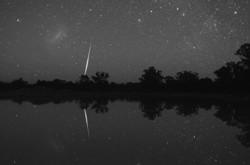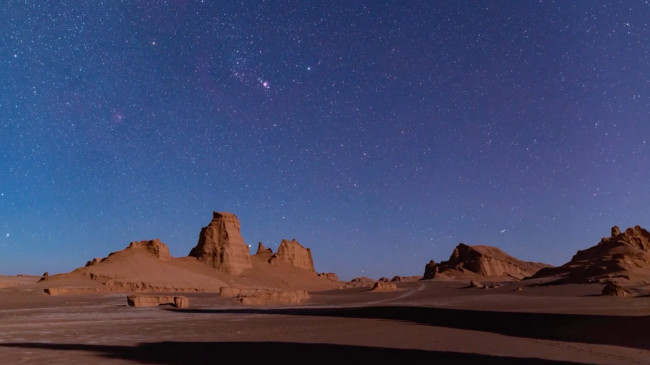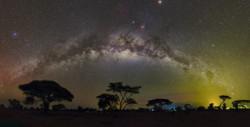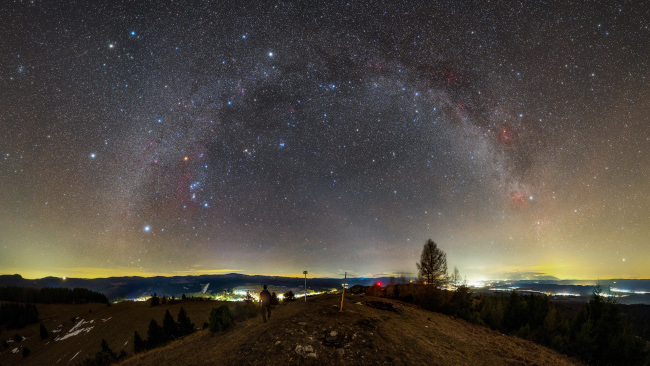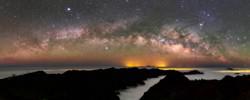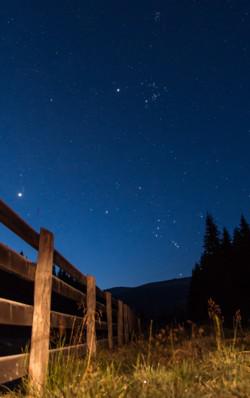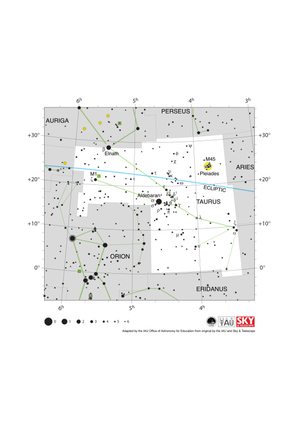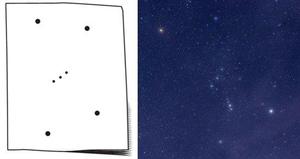Glossary term: Constellation
Description: A constellation in modern technical terms is a polygonal segment of the celestial sphere. The International Astronomical Union has divided the entire celestial sphere into 88 regions – constellations. This is based on those used in Ancient Greece together with more recent additions, especially in the southern hemisphere. Each of the 88 constellations occupies a certain part of the sky, and therefore, each of the heavenly bodies, from stars to galaxies to nebulae, etc., can be associated with a constellation. The Zodiac are 13 constellations that overlap the ecliptic (the annual path traced by the Sun across the celestial sphere). The 13 constellations are: Ophiuchus, Sagittarius, Capricornus, Aquarius, Pisces, Aries, Taurus, Gemini, Cancer, Leo, Virgo, Libra, and Scorpius.
Constellations contain grouping of stars (asterisms) suggesting a pattern as seen from Earth. These patterns are imaginatively described as representing humans, animals, or other recognizable objects.
Related Terms:
See this term in other languages
Term and definition status: This term and its definition have been approved by a research astronomer and a teacher
The OAE Multilingual Glossary is a project of the IAU Office of Astronomy for Education (OAE) in collaboration with the IAU Office of Astronomy Outreach (OAO). The terms and definitions were chosen, written and reviewed by a collective effort from the OAE, the OAE Centers and Nodes, the OAE National Astronomy Education Coordinators (NAECs) and other volunteers. You can find a full list of credits here. All glossary terms and their definitions are released under a Creative Commons CC BY-4.0 license and should be credited to "IAU OAE".
Related Media
Between Two Skies
Credit: Fabrizio Melandri/IAU OAE
License: CC-BY-4.0 Creative Commons Attribution 4.0 International (CC BY 4.0) icons
Constellations from the World
Credit: Stephanie Ye Ziyi/IAU OAE
License: CC-BY-4.0 Creative Commons Attribution 4.0 International (CC BY 4.0) icons
Chilean Nights
Credit: Robert Barsa/IAU OAE
License: CC-BY-4.0 Creative Commons Attribution 4.0 International (CC BY 4.0) icons
Orion Rises Over Mount Etna
Credit: Dario Giannobile/IAU OAE
License: CC-BY-4.0 Creative Commons Attribution 4.0 International (CC BY 4.0) icons
The Culmination of Canopus
Credit: Fabrizio Melandri/IAU OAE
License: CC-BY-4.0 Creative Commons Attribution 4.0 International (CC BY 4.0) icons
Winter Constellations
Credit: Amirreza Kamkar/IAU OAE
License: CC-BY-4.0 Creative Commons Attribution 4.0 International (CC BY 4.0) icons
Cen-Lup-Cru-Panorama: Centaurus Carrying the Beast and Riding Along the Milky Way
Credit: Uwe Reichert/IAU OAE
License: CC-BY-4.0 Creative Commons Attribution 4.0 International (CC BY 4.0) icons
Milky Way Arch over Amboseli National Park
Credit: Amirreza Kamkar/IAU OAE
License: CC-BY-4.0 Creative Commons Attribution 4.0 International (CC BY 4.0) icons
Most Brightest Stars of the Sky
Credit: Giorgia Hofer/IAU OAE
License: CC-BY-4.0 Creative Commons Attribution 4.0 International (CC BY 4.0) icons
Warm Winter Night Over Spiš Region
Credit: Robert Barsa/IAU OAE
License: CC-BY-4.0 Creative Commons Attribution 4.0 International (CC BY 4.0) icons
Luminous Salar de Uyuni
Credit: Stephanie Ye Ziyi/IAU OAE
License: CC-BY-4.0 Creative Commons Attribution 4.0 International (CC BY 4.0) icons
The Hunter in the Forest
Credit: René Antonio Urroz Álvarez/IAU OAE
License: CC-BY-4.0 Creative Commons Attribution 4.0 International (CC BY 4.0) icons
Portrait of a Bat
Credit: Thanakrit Santikunaporn/IAU OAE
License: CC-BY-4.0 Creative Commons Attribution 4.0 International (CC BY 4.0) icons
To guard the Stars and the Sea Together
Credit: Likai Lin/IAU OAE
License: CC-BY-4.0 Creative Commons Attribution 4.0 International (CC BY 4.0) icons
Milky Way Arch over La Palma
Credit: Amirreza Kamkar/IAU OAE
License: CC-BY-4.0 Creative Commons Attribution 4.0 International (CC BY 4.0) icons
Romanian Orion
Credit: Alex Conu/IAU OAE
License: CC-BY-4.0 Creative Commons Attribution 4.0 International (CC BY 4.0) icons
Watchtower and Paddy Fields Under the Starry Sky
Credit: Likai Lin/IAU OAE
License: CC-BY-4.0 Creative Commons Attribution 4.0 International (CC BY 4.0) icons
Winter Constellations
Credit: Mohamed Aboushelib/IAU OAE
License: CC-BY-4.0 Creative Commons Attribution 4.0 International (CC BY 4.0) icons
The Kingdom of Orion
Credit: Carlos Zudaire/IAU OAE
License: CC-BY-4.0 Creative Commons Attribution 4.0 International (CC BY 4.0) icons
Related Diagrams
Andromeda Constellation Map
Credit: Adapted by the IAU Office of Astronomy for Education from the original by IAU/Sky & Telescope
License: CC-BY-4.0 Creative Commons Attribution 4.0 International (CC BY 4.0) icons
Orion Constellation Map
Credit: Adapted by the IAU Office of Astronomy for Education from the original by IAU/Sky & Telescope
License: CC-BY-4.0 Creative Commons Attribution 4.0 International (CC BY 4.0) icons
Sagittarius Constellation Map
Credit: Adapted by the IAU Office of Astronomy for Education from the original by IAU/Sky & Telescope
License: CC-BY-4.0 Creative Commons Attribution 4.0 International (CC BY 4.0) icons
Scorpius Constellation Map
Credit: Adapted by the IAU Office of Astronomy for Education from the original by IAU/Sky & Telescope
License: CC-BY-4.0 Creative Commons Attribution 4.0 International (CC BY 4.0) icons
Libra Constellation Map
Credit: Adapted by the IAU Office of Astronomy for Education from the original by IAU/Sky & Telescope
License: CC-BY-4.0 Creative Commons Attribution 4.0 International (CC BY 4.0) icons
Capricornus Constellation Map
Credit: Adapted by the IAU Office of Astronomy for Education from the original by IAU/Sky & Telescope
License: CC-BY-4.0 Creative Commons Attribution 4.0 International (CC BY 4.0) icons
Crux Constellation Map
Credit: Adapted by the IAU Office of Astronomy for Education from the original by IAU/Sky & Telescope.
License: CC-BY-4.0 Creative Commons Attribution 4.0 International (CC BY 4.0) icons
Aquarius Constellation Map
Credit: Adapted by the IAU Office of Astronomy for Education from the original by IAU/Sky & Telescope
License: CC-BY-4.0 Creative Commons Attribution 4.0 International (CC BY 4.0) icons
Pisces Constellation Map
Credit: Adapted by the IAU Office of Astronomy for Education from the original by IAU/Sky & Telescope
License: CC-BY-4.0 Creative Commons Attribution 4.0 International (CC BY 4.0) icons
Aries Constellation Map
Credit: Adapted by the IAU Office of Astronomy for Education from the original by IAU/Sky & Telescope
License: CC-BY-4.0 Creative Commons Attribution 4.0 International (CC BY 4.0) icons
Taurus Constellation Map
Credit: Adapted by the IAU Office of Astronomy for Education from the original by IAU/Sky & Telescope
License: CC-BY-4.0 Creative Commons Attribution 4.0 International (CC BY 4.0) icons
Cancer Constellation Map
Credit: Adapted by the IAU Office of Astronomy for Education from the original by IAU/Sky & Telescope
License: CC-BY-4.0 Creative Commons Attribution 4.0 International (CC BY 4.0) icons
Leo Constellation Map
Credit: Adapted by the IAU Office of Astronomy for Education from the original by IAU/Sky & Telescope
License: CC-BY-4.0 Creative Commons Attribution 4.0 International (CC BY 4.0) icons
Virgo Constellation Map
Credit: Adapted by the IAU Office of Astronomy for Education from the original by IAU/Sky & Telescope
License: CC-BY-4.0 Creative Commons Attribution 4.0 International (CC BY 4.0) icons
Related Activities
What is a Constellation?
astroEDU educational activity (links to astroEDU website) Description: Investigate three dimensional objects and perspective using constellationsLicense: CC-BY-4.0 Creative Commons Attribution 4.0 International (CC BY 4.0) icons
Tags: Hands-on Age Ranges: 6-8 , 8-10 Education Level: Primary Areas of Learning: Modelling , Social Research Costs: Medium Cost Duration: 1 hour 30 mins Group Size: Group Skills: Analysing and interpreting data , Asking questions , Constructing explanations , Developing and using modelsMake a Star Lantern
astroEDU educational activity (links to astroEDU website) Description: Learn about constellations by building a star lantern.License: CC-BY-4.0 Creative Commons Attribution 4.0 International (CC BY 4.0) icons
Age Ranges: 6-8 , 8-10 Education Level: Primary Areas of Learning: Fine Art focussed , Interactive Lecture Costs: High Cost Duration: 1 hour 30 mins Group Size: Group Skills: Asking questions , Communicating information , Developing and using modelsMoving constellations
astroEDU educational activity (links to astroEDU website) Description: Let's learn how stars in constellations move through time using real astronomical images.License: CC-BY-4.0 Creative Commons Attribution 4.0 International (CC BY 4.0) icons
Tags: Software , Data analysis , stellarium , gaia , hipparcos , ursa major Age Ranges: 10-12 , 12-14 , 14-16 , 16-19 , 19+ Education Level: Middle School , Secondary Areas of Learning: Guided-discovery learning , Observation based , Technology-based Costs: Free Duration: 3 hours Skills: Analysing and interpreting data , Asking questions , Communicating information , Developing and using models , Engaging in argument from evidenceOrion constellation in 3D
astroEDU educational activity (links to astroEDU website) Description: Let's make a simple model of the Orion constellationLicense: CC-BY-4.0 Creative Commons Attribution 4.0 International (CC BY 4.0) icons
Age Ranges: 8-10 , 10-12 Education Level: Primary Areas of Learning: Guided-discovery learning , Modelling , Social Research Costs: Low Cost Duration: 2 hours Group Size: Group Skills: Analysing and interpreting data , Asking questions , Developing and using models